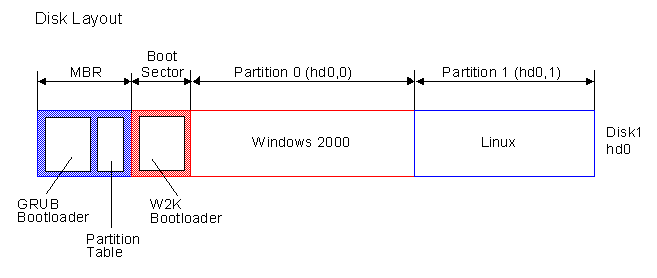

- #Grub4dos boot second partition install
- #Grub4dos boot second partition software
- #Grub4dos boot second partition windows
I hope the suggestions here helped you to get the Grub boot menu back and you can now use it to enjoy both Windows and Linux. I verified everything by accessing the UEFI firmware settings in Windows 10. It was just the UEFI settings that were different in the boot manager.
#Grub4dos boot second partition install
Seemed like Linux partition disappeared but no – the Linux install on the other partition was safe and sound. Did it work?įrustrating, isn’t it? It seemed like there was no way to access Linux at all. If you see a “no boot found” error, you can try this or this solution. If you’re not able to boot into the Windows installation, insert the Windows installation disk and there you’ll have access to the command prompt. In here, copy and paste the command below: bcdedit /set path \EFI\Microsoft\Boot\bootmgfw.efi Other distributions might have some other folder name. Under the boot tab, look for the Add Boot Option.



If it is the same case with you, go to BIOS settings. This means that in the boot settings, there is only Windows, no Linux option. One other common issue that many people encounter is the absence of Linux grub entry from the boot options. If a few weeks or months down the line, the problem comes again after a Windows update, you can use this same method here.īut if there is no Ubuntu/Linux option in the boot menu? Method 2: Add Linux boot entry in the boot settings If you are lucky, this should fix the issue for you. Helpful keyboard shortcuts are always displayed in the boot menu. Select it and move it up the order using F5 key. You should see the option to access boot settings. If you can see both Windows and Linux boot options and Windows boot is above Linux, you have to change the boot order. You can use GParted or the Ubuntu Live CD or any other Live USB/CD that suits you.Make sure that Ubuntu is above Windows in the boot order If these didn't fix your problem, you might want to have a closer look at your hard disk's health and partitions. If things go well and if GRUB was the reason for your troubles, you just fixed them. Next, unmount the partition via sudo umount /mnt and then reboot your computer.Īfter running these steps, you should be able to restore GRUB within 5 minutes. Then issue the command sudo grub-install -root-directory=/mnt /dev/sdX X being the hard disk where you want to restore GRUB. NOTE: If you have a separate boot partition, you will need to mount it explicitly at /mnt/boot You can use sudo fdisk -l, to list all partitions if you are not sure about the system partition. eg mount /dev/sda3 /mnt, in which case /dev/sda3 is your Linux system partition. Similarly (hd0,2) means second partition on the first hard disk.Įnter sudo mount /dev/XdYZ/ /mnt where X can be either 'h' or 's' and Y represents the hard disk number and Z represents the partition. Before we proceed keep in mind that hd0 refers to the first hard disk on your computer, second will be hd1 and so on. Next up - fire up terminal and get ready for some command line action. UEFI support seems to have been added in version 6 of SYSLINUX, while Slackware comes. The Syslinux Project, of which SYSLINUX the boot loader is a part, contains also ISOLINUX, EXTLINUX and PXELINUX, basically its variants to boot from optical media, ext2/3/4, Btrfs, XFS, UFS/FFS and NTFS or from network. This can be insured by using the disc that you used to install Linux.īoot off from the Live CD and give it some time before you can view the desktop. SYSLINUX is a boot loader that loads Linux (among other things) from FAT filesystem. Keep in mind that the CD uses same version of GRUB. You can also use Knoppix or SystemRescueCD. Your Linux distro CD should work just fine if it installed GRUB on your computer in the first place. (I would bet on the first) See if using the modified NTDETECT. It can be caused by either the ERD having problems with your particular setup or by NTDETECT.COM problems with your hardware. Sadly, the procedure is a little different for both versions and we shall tackle both of them here.įirst off, you need a Live CD handy. Well, the 0x0000007b error means inaccessible boot device.
#Grub4dos boot second partition software
Let's see how.įirst off, as is often the case when a new version to a popular software is released, both versions continue to be in use for some time before the newly version is adopted. Its to restore GRUB, and you can do it in a snap. In either case, before you panic and rush to forums or tech support, there is a simple fix that will most likely alleviate your woes. In that case, depending upon what you just did, you might only be able to boot into Windows or GRUB might fail to display any menu at all. If you go the other route, that is - install Windows after Linux, or if you play with partitions on your hard drive too much you can end up messing up GRUB.


 0 kommentar(er)
0 kommentar(er)
